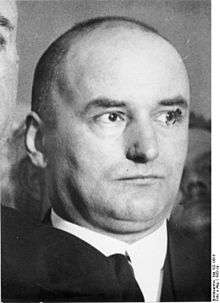Erich Klausener
Erich Klausener (25 January 1885 – 30 June 1934) was a German Catholic politician who was killed in the "Night of the Long Knives", a purge that took place in Nazi Germany from 30 June to 2 July 1934, when the Nazi regime carried out a series of political murders.

| Part of a series on |
| Persecutions of the Catholic Church |
|---|
|
Overview
|
|
|
|
Family
Born in Düsseldorf to a strict Catholic family, he was a distant member of the Cluysenaar family. Klausener followed his father's career in public service, serving for a time in the Prussian Ministry of Commerce.[1] He served as an artillery officer in Belgium, France and on the eastern front of World War I, and was awarded the Iron Cross Second Class in 1914 and the Iron Cross First Class in 1917. Klausener's participation in a boycott during the French occupancy of Ruhr in 1923 and 1924, however, earned him a sentence of two months in prison.
Career
From 1924, Klausener served in Prussia in the Ministry of Welfare, and later headed the police division Ministry of Interior of that state. From 1928, Klausener became head of the group Catholic Action (German: Katholische Aktion). Before 1933, he strongly supported the police battle against illegal Nazi activities. After Adolf Hitler and Nazis came to power in 1933, Hermann Göring became minister-president of Prussia. Klausener was displaced from the ministry of transport of Prussia when Göring started to Nazify the Prussian police, and Klausener was transferred to the Reich Ministry of Transportation.[1]
A close associate of Vice Chancellor Franz von Papen, Klausener contributed to his Marburg speech delivered on 17 June 1934. The speech, though moderate in tone, criticized the violence and repression that had followed since Hitler became Chancellor. Klausener spoke at the Catholic Congress in the Berlin's Hoppegarten on 24 June 1934. His passionate criticism of the repression was viewed by the Nazis as an open challenge.[1]
Six days later, during the "Night of the Long Knives", SS officer Kurt Gildisch was ordered by Reinhard Heydrich to go to Klausener's office at the Ministry of Transport to assassinate him. After the killing, Gildisch was promoted in rank to SS-Sturmbannführer.[2]
After the end of the Nazi regime and after World War II, a monument was erected to Klausener in Berlin. In 1963, his ashes were buried in a grave in the Catholic Church Maria Regina Martyrum, in commemoration of the martyrs of the Nazi era. His grave is in the Friedhof St. Matthias, Berlin.[3]
References
- "Erich Klausener", German Resistance Memorial Center
- Hoffmann, Peter (2000) [1979]. Hitler's Personal Security: Protecting the Führer 1921-1945, p. 49, ISBN 978-0-30680-947-7.
- http://www.findagrave.com/cgi-bin/fg.cgi?page=gr&GSln=Klausener&GSbyrel=all&GSdyrel=all&GSob=n&GRid=25075103&df=all&
External links
- Brief biography of Erich Klausener – from the German Resistance Memorial Center
- Martin Persch (1992). "Erich Klausener". In Bautz, Friedrich Wilhelm (ed.). Biographisch-Bibliographisches Kirchenlexikon (BBKL) (in German). 3. Herzberg: Bautz. cols. 1570–1573. ISBN 3-88309-035-2.
- Newspaper clippings about Erich Klausener in the 20th Century Press Archives of the ZBW
See also
- Herbert von Bose
- Edgar Julius Jung
- Franz von Papen